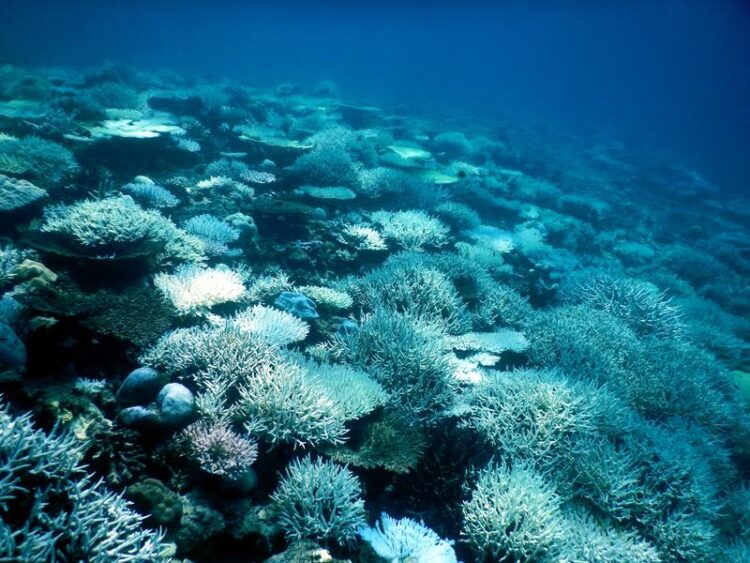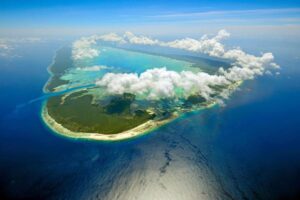Young Corals Provide Insight into Recovery from Coral Bleaching

Coral bleaching of a reef near to Mahé, Seychelles. Coral bleaching can lead to the death of entire reefs.
(c) Anna Koester
The number of young corals can reveal how reefs are recovering from coral bleaching. A new study from the University of Bremen, which was recently published in “PLOS ONE” journal, has shown this.
The warming of the oceans due to climate change and the subsequent increase in frequency and severity of coral bleaching are the worldwide biggest threats to coral reefs. Thus, how quickly coral reefs can recover from such bleaching is of great interest and the number of young corals provide a good insight. Researchers involved in an international research project within the Marine Ecology group at the University of Bremen and investigated this matter together with the Seychelles Islands Foundation (SIF) based on an isolated atoll in the Indian Ocean – with promising results. Within four years after the coral bleaching of 2016, the number of young corals multiplied two to threefold when compared with the situation directly after the bleaching.
“Much like adult corals, juvenile corals may be severely affected by bleaching and die. However, one type of coral bleaching also affects adult corals’ ability to reproduce. This means that the multiplication and thus the number of young corals may remain suppressed for several years after bleaching,” explains Professor Christian Wild, head of the Marine Ecology group at the University of Bremen.
Dr. Anna Koester, who recently completed her PhD at the University of Bremen, is the principle author of a study that has been published in “PLOS ONE” journal. The marine ecologist says: “The rapid increase in young corals that we have observed in the four years after coral bleaching is a good sign that the reefs of the Aldabra Atoll are recovering and it also fits well with our previous work.”

(c) Natura/Seychelles Islands Foundation
The Aldabra Atoll is one of only 50 marine UNESCO World Heritage Sites and lies far away in the Indian Ocean. Human-based, local factors, such as the input of nutrients or overfishing, play basically no role there, explains the scientist. However, the last case of coral bleaching in 2016 caused around two thirds of the corals to die. Thus, it is the ideal place to find out how the condition of damaged reefs changes when they is no exposure to any stress factors directly caused by humans.
In order to gain a basic understanding of the reproduction of corals at the Aldabra Atoll, researchers also took a closer look at the settling of coral larvae as part of the study. “Our findings suggest that coral spawning mainly takes place between October and December at the Aldabra Atoll. That is important information for further studies that investigate which reefs in the region contain coral larvae from Aldabra and thus also profit from Aldabra’s protection,” states Koester.
“Due to climate change, we expect there to be an increase in frequency of coral bleaching. This means that the period for reef recovery between coral bleaching occurrences will become continually shorter,” emphasizes Wild. Reducing the triggers of coral bleaching, especially the increase in ocean temperature, is therefore essential, as even isolated and strictly protected reefs, such as the Aldabra Atoll, will otherwise not have enough time to recover soon.
Wissenschaftliche Ansprechpartner:
Dr. Anna Koester
Email: anna.koester@uni-bremen.de
Prof. Dr. Christian Wild
Email: christian.wild@uni-bremen.de
Originalpublikation:
Koester, A., Ford, A. K., Ferse, S. C. A., Migani, V., Bunbury, N., Sanchez, C., and Wild, C. 2021. First insights into coral recruit and juvenile abundances at remote Aldabra Atoll, Seychelles. PLoS ONE 16(12): e0260516. https://doi.org/10.1371/journal.pone.0260516
Media Contact
All latest news from the category: Ecology, The Environment and Conservation
This complex theme deals primarily with interactions between organisms and the environmental factors that impact them, but to a greater extent between individual inanimate environmental factors.
innovations-report offers informative reports and articles on topics such as climate protection, landscape conservation, ecological systems, wildlife and nature parks and ecosystem efficiency and balance.
Newest articles

Innovative 3D printed scaffolds offer new hope for bone healing
Researchers at the Institute for Bioengineering of Catalonia have developed novel 3D printed PLA-CaP scaffolds that promote blood vessel formation, ensuring better healing and regeneration of bone tissue. Bone is…

The surprising role of gut infection in Alzheimer’s disease
ASU- and Banner Alzheimer’s Institute-led study implicates link between a common virus and the disease, which travels from the gut to the brain and may be a target for antiviral…

Molecular gardening: New enzymes discovered for protein modification pruning
How deubiquitinases USP53 and USP54 cleave long polyubiquitin chains and how the former is linked to liver disease in children. Deubiquitinases (DUBs) are enzymes used by cells to trim protein…



